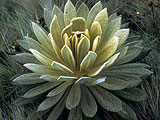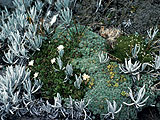 |
|
|
|
|
|
|
At c. 4000 m elevation woodlands of Polylepis and Gynoxis would naturally give way to tall tussock grassland, shrubs and giant rosettes forming páramos vegetation. Quite often this transition is seen at lower elevation because of fire management. The Ecuadorian páramos region is a rather humid environment, only above 4500 m at some of the high volcanoes of central Ecuador can it get drier. |
|
1 - Tall tussock grassland at 4000 m near Paso de la Virgen (with Poa, Festuca, Agrostis and Stipa (all Poaceae) species) 3 hours' driving distance from Quito. |
|
|
2 - Chuquiraga sp. (Asteraceae) (Paso de la Virgen, 4000 m) |
3 - Peculiar rosettes of Werneria sp. (Asteraceae). |
4 - Hypochoeris sp. (Asteraceae) (Páramos de la Virgen). |
|
5 - The bromeliad Puya sp. (Bromeliaceae) forms giant rosettes and similarly gigantic inflorescences (4000 m). |
6 - An old Puya inflorescence (4000 m). |
7 - Vegetative rosettes of Puya sp. (4000 m). |
|
8 - Páramos el Angel (3600 m), with "giant rosette" Espeletia sp. (Asteraceae). |
|
|
9 - Espeletia sp. (Asteraceae) |
10 - Espeletia sp. (Asteraceae) |
11 - Espeletia sp. (Asteraceae). Note the thin layer of water intercepted from fog and prevented from wetting the epidermis by pubescence. |
|
12 - Lupinus allepecuroides (Fabaceae). In the footsteps of Alexander von Humboldt on Guagua Pichincha near Quito (4400 m). |
13 - Lupinus allepecuroides (Fabaceae). Leaves are covered with white hair. |
|
14 - The Cayambe volcano (5790 m). |
|
|
15 - Azorella sp. (4700 m) |
16 - A mix of cushion plants (Azorella sp. (Apiaceae), Hypochoeris sp. (Asteraceae), Cerastium (Caryphyllaceae)) and Culcitium nivale (Asteraceae) (Cayambe, 4600 m). |
17 - Azorella cushion (4600 m). |
|
18 - Culcitium nivale (Asteraceae) (Cayambe, 4600 m). Compare the inflorescence with Espeletia lutescens in Venezuela. |
19 - Note the narrow range of diurnal temperatures in this almost permanently foggy elevation between 4500 and 4700 m. |
20 - Agrostis sp. (Poaceae) (4800 m). |
|
21 - A selection of typical high Andean plant species at 4700 m elevation on Cayambe: Cerastium sp. (Caryophyllaceae), Culcitium nivale (Asteraceae), Luzula sp. (Juncaceae), Hypochoeris sp. (Asteraceae), Azorella sp. (Apiaceae, center), small rosettes of Draba sp. (Brassicaceae), Aa sp. (Orchidaceae, bottom center), Hybertia sp. (Lycopodiaceae, right). |
22 - Leaf shape patterns at 4700 m on Cayambe. The biggest (white) leaf is from Culcitium nivale and is c. 12 cm long (see Fig. 18). |
29 August 2011 |
||
| |
||
























